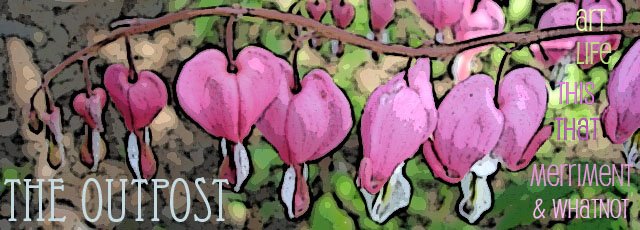Friday, August 02, 2013
Thursday, March 07, 2013
Shadow Weave Chenille Scarf
 |
| Art Outpost: Shadow Weave Chenille Scarf |
Finally finished this shadow weave scarf! It's not that I've been working on it steadily ... there have been a few other projects in between ... but it had been going at rather close to Snail's Pace.
There was plenty I didn't understand about how best to work with chenille yarn. The first mostly successful attempt at weaving with chenille was evidently a lucky break, and everything that could go wrong went wrong this time, beginning with winding the warp and ending with ... oh ... completely starting over again ... the second time with the indispensable help of Su Butler's CD version of her book Understanding Rayon Chenille.
What makes the shadow in shadow weave are the alternating "dark" and "light" threads in warp and weft ... in "the Atwater method of threading shadow weave, the basic pattern is drawn on alternate threads and then the "shadow" threads are filled in on the "opposite" shaft." That explanation is straight from A Weaver's Book of 8-Shaft Patterns, and the pattern used for this scarf is an "undulating twill" (#303 on page 77).
I still have trouble getting the fringes right, though I seem to be getting closer. Here's my old Riverside Shakespeare put to good use weighting down the scarf so I can evenly tie the knots. The gadget on top of the book is a novelty instrument made for twisting hair, and it works a treat for twisting fringe (actually a lot easier than trying to twist my hair). I'll need more practice to figure out exactly how much to twist and then retwist the opposite direction ... it's supposed to be exactly the same number, but I haven't figured out yet how to accurately count while using this device. I'm guessing this is why some of the yarns in some of the fringe doubled up and tangled with each other at the fell line after taking the scarf out of the dryer.
It's quite remarkable the difference in the hand and softness of the chenille after it's been wet-finished. It comes off the loom as stiff as a board, and after it's been washed and dried it's soft, supple, and very luxurious. (The scarf on the left is post-finishing ... impossible to convey the difference in a picture, but it definitely looks velvety.)
Just by changing the treadling of the same draft you can get a completely different look. The sample on the right will be the pattern for another scarf (same threading and tie-up, different treadling order) in a brighter red and black yarn instead of gray. With any luck, this one will go a lot faster and will not involve too much in the way of cursing and wringing hands.
Friday, January 25, 2013
Word as Image
Illustrations from Ji Lee's video Word As Image.
The whole alphabet, complete with sound effects, is here.
Wednesday, January 09, 2013
The ABC of Architects
The ABC of Architects from fedelpeye on Vimeo.
"The ABC of Architects, an alphabetical list of the most important architects with their best know building directed by Federico Gonzalez and animated with Andrea Stinga."
Well, this is cool. I even recognize a few of the buildings.
via notcot.org
Tuesday, January 08, 2013
The Book Club of California Centennial
The design for the centennial celebration of The Book Club of California via Felt & Wire.
I am completely charmed by the idea of a book club devoted to the love of the printed book, whose members include artists, collectors, and printers. If you're one of the 1000 members you receive a letterpress printed "Quarterly News-Letter" ("QN-L" for short) and other exclusive printed perks. Sweet.
The claim is that the newsletter is the only letterpress printed newsletter in the U.S. There are pictures of various covers of previous newsletters on the site, and a notice that some issues can soon be read via a PDF.
This logo was designed by designer Michael Osborne, and I took particular note because I just designed, in my own bumbling Illustrator way, a similar rectangle as a return address for myself.
Subscribe to:
Comments (Atom)





